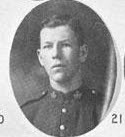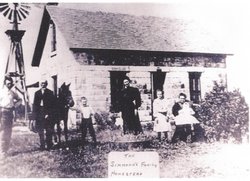GRAHAM GHOST STORIES
George M. Graham was my 4th cousin, twice removed. He was born in 1854 in Lower Economy, Colchester County, Nova Scotia. As an old man, he loved to regale his family with tales of the supernatural.
One of his stories was about the old grandfather clock that stood guard over the front parlour. The clock, having been brought by his father, James from Dumfries, Scotland had stood silent for many years. George had two older sisters, Mary and Martha and in October 1959 both girls came down with diphtheria. On the night of October 14th of that year the clock suddenly came to life and chimed the hour. Shortly thereafter, Mary succumbed to the deadly disease. Again during the night of the 19th, the clock chimed as Martha quietly passed away. From there on after, the clock remained forever silent.
When George was a small boy, he was sent out to the barn to do his chores and was startled to find the family sled, which had been left by the woodpile had disappeared. He followed the tracks and found the sled halfway up a hill about 1/4 mile from home. Returning the sled to its place in the yard, the young lad went to get the colt, that he had let out earlier for water earlier. He was amazed to find the colt, tucked up in his stall in the barn, the stall door securely locked and fresh hay in the manger. In both cases, no footprints could be seen in the snow and no one else from the family had ventured out of the house that morning.
So, who moved the sled and who put the colt back in his stall......?
THE GREAT AMHERST MYSTERY
 |
Daniel Teed's Home in
Amherst |
The story of Esther Cox is renowned across Canada and has been the subject of several books and a stage play. Her story is quite amazing!
Esther Cox was born to Archibald Thompson Cox and Esther Logan Fisher on the 28th of March 1860 in Upper Stewiacke, Colchester County Nova Scotia. She was the youngest of six children. Her older sister was married to Daniel Teed, my 3rd cousin, twice removed who worked as a shoemaker in Amherst, Cumberland County. And it was in Olive and Daniel's home that most of the poltergeist activity took place.
Esther Cox began experiencing unexplained phenomena in late August 1878 after being assaulted by her boyfriend, Bob MacNeil. The manifestations of a poltergeist continued for more than a year.
The poltergeist took different forms, expressing itself originally through the movement of bedclothes and other articles and through loud rappings. By October 1878 manifestations were more aggressive; furniture was tipped over and Esther complained of being pursued by objects, especially when in the basement. The poltergeist communicated with observers, answering their questions with knocks and, at times, by writing on walls. While some of the written messages were too profane to be published in newspapers, the sensational "Esther Cox, you are mine to kill" was widely reported.
After the ghost threatened to burn down the Teed home, lighted matches reportedly fell from the ceiling and two unexplained fires were discovered. From the beginning Esther suffered physical symptoms that included spells characterized by swelling of her body and uncontrollable movement of her limbs.
In June 1879 Cox began to tour, accompanied by actor and writer Walter Hubbell and a local businessman, John White. They returned home following only two engagements in New Brunswick, however, after they were frightened by disapproving members of the audience. Esther's manifestations ended in November 1879.
At that time she was sentenced to four months in jail for burning down a barn belonging to the family with whom she was living. Reportedly she was released at public urging after serving one month. Subsequently, no accounts of disturbances appear in newspapers. One interpretation is that she had been cured by a Micmac shaman.
In 1882 she had married Adam Porter and was living in Springhill. They had one son. Apparently her married life was unaffected by poltergeists and she ended her years quietly in Brockton, Massachusetts, married to Peter Shanahan, where few, if any, knew of her earlier fame.
THE GHOST OF OLD BILL EAGLES
Sometime about the year 1880 a man,
WILLIAM EAGLES by name, disappeared on Westchester Mountain. A search was made for him but he was not found. Bill, as he was called, was my 1st cousin, 3 times removed.
Some time after, a ghost was reported to have been seen by several different people, and always at the same place on the Halifax road. One evening, the sun was down, but it was not dark,
Hugh Scott, (whose stepmother was my 2nd cousin, three times removed) who had been on a short visit to his brother
William, was coming home over the mountain on horse back. His horse had trotted or cantered for several miles. He had eased him down to a walk and was about to fill his pipe, that he had taken from his pocket, along with his knife, and tobacco. He started to the cut the tobacco, when he noticed what he supposed was someone walking close to his stirrup.
He took a second look and recognized Bill Eagles. Frightened, he then whipped up his horse and hurried away from there.
Some time after he met his brother William, who asked Hugh why he did not speak to Eagles and said that if he ever saw the ghost he would ask him what he wanted.
Several months after this William Scott was travelling the same road on the way to visit Hugh and at nearly the same place on the road he had allowed his horse to walk and had started to fill his pipe, when he noticed Bill Eagles walking beside his horse.
William Scott said,
"Hello, Bill, what do you want?"
Bill Eagles said,
"I want to be buried."
William Scott said,
''How will I find you?"
Eagles said,
"You will find me just a short way up this little brook under a pile of old brush."
William Scott said,
"All right, Bill, I'll attend to that tomorrow", and went on his way to Hugh Scott's.
Next morning he wanted Hugh to go with him to look for Bill Eagles' remains. Hugh could not go, so William went up on the mountain and got someone to go with him. They found the pile of old brush without much trouble, gathered Eagles' bones up the best they could, carried them out and buried them.
Bill Eagles' ghost was never seen again.
LADY IN THE WINDOW
Two summers ago, I had an opportunity to take a look inside the old Anglican Church at Oxford Junction. The church was built in 1857 by Theodore Harding Carter in preparation for his marriage to Amy Ann Bragg, daughter of John Bragg and James Rogers of Windham Hill. The lumber for the church came from John Bragg's wood lot. Since then the little churchyard has been the final resting place for John and Jane Bragg and many of their descendants.
In going through my photos of that day, I was startled to see the figure of a woman in the centre window behind the altar. She appears to be wearing old fashioned clothes and I believe her to be my great grandmother, Matilda Swallow Bragg who died in 1896 and is buried with her husband, Charlie and several of her children in the little cemetery outside.Matilda connects us to our United Empire Loyalist ancestors and I would like to think that she was there that day to welcome us to this epicentre of the Bragg Family Tree.
THE LITTLE GIRL IN THE ROAD
 |
| The little girl in the road. |
A story from Ed Gilbert of the Families of Cumberland County, tells still another interesting tale:
I read this story in an old newspaper. A fellow named Adams was driving home when he came upon a little girl, terribly wounded and bleeding. When he got down from his horse to help her, she vanished. No tracks, no blood - nothing to tell she had been there. I'm not sure this Adams is connected to our family, but we have quite a crew of Adams' in the Wentworth area - so, could be!








































